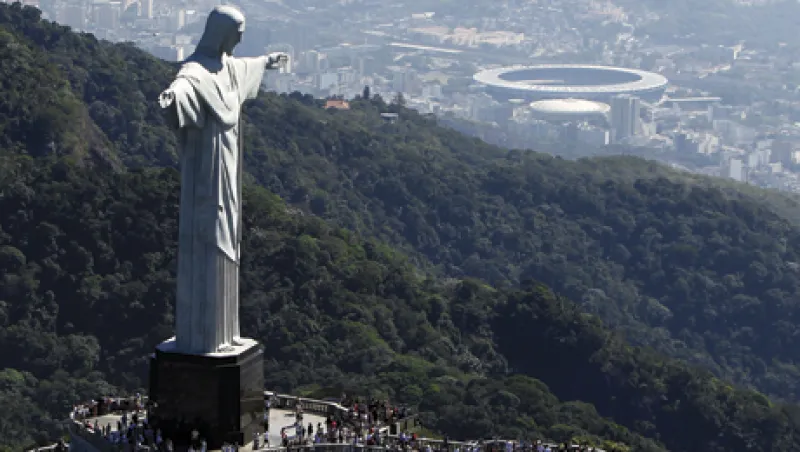LOOKING TO MAKE ITS FIRST EXPANSION OUTSIDE the U.S., Direct Edge, an upstart electronic stock exchange, decided in November to launch a bourse in Brazil to take advantage of the country’s fast-growing equity market. But rather than open in São Paulo, the Brazilian business capital that’s home to the incumbent BM&FBovespa stock exchange, Direct Edge will set up shop in Rio de Janeiro. The city’s booming asset management industry was a key factor in the decision, as was the fact that the Comissão de Valores Mobiliários, the Brazilian securities regulator, is based there, says Anthony Barchetto, head of strategy at the Jersey City, New Jersey–based firm.
“The city government is very keen to bring a proper exchange back to Rio,” Barchetto explains. “For us that is one of the key reasons we opted for Rio. That political support is very beneficial, in particular when we have to talk to officials of the CVM.”
Rio de Janeiro is known as the cidade maravilhosa — “the marvelous city.” Today more than ever, there is a great deal to marvel at.
Brazil’s second city, which has languished for decades in the shadow of its larger rival to the southwest, is enjoying an unprecedented economic boom. The local asset management industry is thriving, especially hedge fund managers who find that Rio’s financial heritage, natural beauty and easygoing lifestyle make an attractive environment for doing business. The discovery in the past decade of vast oil reserves some 250 kilometers (155 miles) off the Rio coast has attracted an influx of investment and talent from companies foreign and domestic, led by state-owned Petróleo Brasileiro (Petrobras), which has its headquarters in the city. And a massive investment in infrastructure ahead of the 2014 FIFA World Cup and the 2016 Summer Olympic Games is fueling economic activity and promising to overhaul Rio’s roads, ports and buildings for the 21st century.
“The World Cup and the Olympics are incredibly important,” says Marcelo Haddad, executive director of Rio Negócios, the city’s inward investment agency. “They will raise the city’s international profile greatly. Furthermore, they create fixed dates by which huge infrastructure projects must be completed. Those plans are transforming Rio and will make the lives of cariocas [as residents of Rio are known] a lot easier.”
The scale of the investment is staggering. For the two sporting extravaganzas, the government and the private sector are expected to spend some 23 billion reais ($13.4 billion) on stadiums, an Olympic village, an extension of the subway, a new rapid-transit bus network, hotels and other facilities. The city’s revival is also spurring a range of other investments, such as the multibillion-dollar Marvelous Port Project, a massive waterfront development likened to London’s Canary Wharf that is expected to create 50 million square feet of high-quality office, retail and residential space.
The oil boom is generating even bigger investment flows. Petrobras alone plans capital spending of $212 billion between 2010 and 2014 to develop the country’s offshore oil resources. “The oil and gas discoveries are absolutely huge and were great news for Rio,” says Haddad. “The capital expenditures involved are vast. It is on the scale of America’s Apollo program to put a man on the moon.”
Although only a fraction of that investment will be spent directly in Rio, the energy sector is drawing thousands of executives and engineers to the city and spurring a wide range of foreign companies — from Russia’s Gazprom to Dow Chemical Co. — to establish offices there. “Dow came to Rio because of the amazing opportunities the city offers,” says Lauro Rebouças, director for Dow Brazil, a subsidiary of the U.S. chemical company, who recently moved from São Paulo to open the company’s Rio office. “Developments in the oil and gas sector were the major attraction. It’s not just Petrobras — all the world’s most important oil companies, including Shell, Total and BP, have their Brazilian base here. It’s vital to have an office near theirs.”
Rio’s revival is about more than just investment flows, as important as those are. The authorities have been moving aggressively in recent years to repair the city’s stretched social fabric. They have sent teams of police and army troops into the notorious favelas, or hillside slums, to root out drug gangs that terrorized local residents, and extended utility services and transport links to knit those hillside neighborhoods into the city’s economy (see story, above).
These forces have combined to give Rio a newfound energy and dynamism: a hint of Houston from the oil money, echoes of New York’s financial sector without its gloom, a touch of London’s cosmopolitan nature, all leavened with the distinctive joie de vivre of the cariocas.
With a population of 6.3 million — 12.3 million in the greater metropolitan area — Rio is the second-largest city in Brazil and the fourth largest in Latin America after Mexico City, São Paulo and Buenos Aires. It has long had enviable economic strengths. Rio’s per capita gross domestic product stood at 25,122 reais in 2008, 57 percent above the national average, according to the Brazilian Institute of Geography and Statistics. Some 56 percent of Brazil’s economic output is produced within a 500-kilometer radius of the city; Rio receives a quarter of all foreign direct investment in Brazil, which totaled $48.46 billion in 2010, according to the United Nations’ Economic Commission for Latin America and the Caribbean.
Six of the country’s 13 largest companies have their headquarters in Rio, including Petrobras, mining giant Vale, mobile telecommunications operator TIM Brasil and EBX, the holding company of Eike Batista, Brazil’s richest man. BNDES, the state-owned entity that is the world’s largest development bank, with some 625 billion reais ($366 billion) in loans outstanding, is based in the heart of the city center, just across the street from Petrobras. Rio is also home to Globo Organizations, the largest media conglomerate in Latin America, and it boasts nearly a dozen leading universities, including the Getulio Vargas Foundation, which operates Brazil’s top management school.
The city’s revival won fresh validation in December when Moody’s Investors Service raised its rating on Rio to Aaa.br, the highest level on its local scale. Moody’s cited the city’s strong finances — the budget had a gross operating surplus of 17.4 percent of revenue in 2010 — a healthy tax base and reliable transfers from the state and federal governments. Rio is the only Brazilian city to have an investment-grade rating from the U.S. agency.
FOUNDED BY PORTUGUESE COLONISTS IN 1565 ON Guanabara Bay, an inlet of the Atlantic Ocean, Rio de Janeiro served as the capital of Brazil from 1763 to 1960. Its verdant hillsides and spectacular beaches provide one of the most stunning urban settings in the world, with famed Sugar Loaf Mountain standing at the entrance to the bay and the giant statue “Christ the Redeemer” looming over the city from the top of Corcovado. The rich and glamorous have frequented the beaches of Copacabana, Ipanema and Leblon since the 1920s. The world-renowned Copacabana Palace hotel was opened in 1923.
The city’s international profile grew following the release of the 1933 musical Flying Down to Rio, the first screen pairing of Fred Astaire and Ginger Rogers. In the mid-’60s the bossa nova song “Garota de Ipanema (The Girl from Ipanema),” was a worldwide hit.
That same decade Rio fell into decline. The nation moved its capital to the brand-new city of Brasília, and the business center of gravity began shifting to São Paulo. The Rio de Janeiro Stock Exchange, which was founded in 1820 and long reigned as the country’s largest, waned after a crash in 1971. It was overtaken in size by São Paulo–based Bovespa later that decade, ceased equity trading in 2000 to focus on government bonds and currencies, and was acquired in 2002 by commodities and futures exchange Bolsa de Mercadorias & Futuros, now part of BM&FBovespa.
A decade ago Rio looked like a city whose best days were behind it. Many neighborhoods, including Copacabana and the downtown area, looked gray and run-down. The city had a provincial feel, especially compared with bustling, cosmopolitan São Paulo, home to the bulk of Brazil’s expatriate community and most of the best restaurants. Social order was on the verge of breakdown, with violent crime rampant in the favelas and kidnappings and murders commonplace even in upscale neighborhoods. The style and sophistication of the bossa nova years had given way to a gritty reality of squalor and mayhem, as depicted in the 2002 Fernando Meirelles film City of God.
“It was a bit like New York City in the ’80s,” says Rio Negócios’ Haddad.
In the past decade, however, several factors sparked a turnaround — one that was barely perceptible at first but gained steam rapidly.
In October 2006 the U.K.’s BG Group discovered the Tupi oil field in the deepwater Santos Basin, off the coast of Rio. It was the biggest oil find in the Western hemisphere in 30 years, containing as much as 8 billion barrels. The discovery led then-President Luiz Inácio Lula da Silva to declare that Brazil had found its independence for a second time. Two years later Petrobras announced that it too had struck black gold in the Santos Basin. The Jupiter field, located a bit further offshore, is believed to hold between 5 billion and 8 billion barrels of crude.
The twin discoveries have turned Brazil’s continental shelf into one of the hottest oil and gas exploration zones in the world. They promise to transform the economic prospects of the country, turning it from a large oil importer to an exporter. Petrobras is ramping up its capital spending in a bid to more than double its production, from 2.5 million barrels of oil equivalent per day in 2010 to 5.4 million in 2020. As the oil and gas industry’s hub, Rio stands to receive a good share of the newfound bounty.
Another turning point came in 2007 when Sergio Cabral, the newly elected governor of the state of Rio de Janeiro, began a long-overdue crackdown on crime in the city. “The governor decided that the level of violence was unsustainable,” says Rio Negócios’ Haddad. “Here we were, living in one of the most beautiful places in the world, but the quality of life was being undermined by all the killings and by all the crime.”
The authorities created “pacifying police units” to enter no-go areas in some of the city’s most dangerous favelas, arrest drug traffickers, break up organized-crime gangs, and restore or improve public services. The program has had its trials, to be sure. In one early operation, an invasion by heavily armed police and army troops of the Vila Cruzeiro favela in November 2010 left 31 people dead. But the initiative has managed to clean up 19 favelas so far, and authorities aim to reclaim a further 21 neighborhoods over the next two years.
The pacification drive is crucial to bridging the vast socioeconomic gap between Rio’s slums and wealthy neighborhoods like Leblon, an exclusive coastal enclave on the southern end of the city. “You cannot really escape from the favelas in Rio,” says Gordon Lewis, a Briton who is joint partner and founder of LondonRio, a commercial and residential property developer. “They are dotted all over the city. Executives may live in Leblon, but a company’s security guards and window cleaners will live in the favelas. That is why it’s important that the favelas are being sorted out.”
The final key element in Rio’s revival: the 2014 World Cup and the 2016 Summer Olympics. In 2007, Brazil won the right to host football’s quadrennial festival, with several matches, including the tournament final, to be held in Rio. Two years later the International Olympic Committee awarded the 2016 games to Rio, which beat out competition from Chicago, Tokyo and Madrid. This will be the first time that one city has hosted the world’s two largest sporting events in succession, and it is a dramatic symbol of Rio’s renaissance.
The twin events are spurring an unprecedented construction boom in and around the city. Rio’s famous Maracanã Stadium is undergoing a $1 billion renovation to make it a fitting venue for the World Cup final and the opening and closing ceremonies of the Olympic games. Last month the city completed its first Olympics venue, a renovation of its famed Sambódromo stadium, just in time for the annual Carnival celebration.
The city is spending $8.3 billion on overhauling its transportation infrastructure. It is building 150 kilometers of roads for a new rapid-transit bus system to connect Rio’s northern and western zones, with dedicated lanes for articulated buses capable of carrying up to 300 passengers each. The project, which includes the purchase of 1,300 buses, is being financed by the federal, state and city governments, with loans from the World Bank and Inter-American Development Bank. “Rio will be the only major city in Brazil that will have a mass rapid-transit system between the city center and the international airport,” says Rio Negócios’ Haddad.
All of these factors have created a powerful momentum and made Rio a magnet for people — and money — from across Brazil and around the world.
Dow Brazil’s Rebouças says the company was attracted to Rio by more than just oil. “There are big opportunities for Dow coming from the huge infrastructure projects under way in the city,” he says. “It’s no longer São Paulo that is attracting the country’s top talent. All the top engineers in Brazil now want to move to Rio.”
Rebouças jumped at the opportunity when his bosses asked if he would like to open up Dow’s Rio office. A 33-year veteran of the chemicals company, he stared out at a concrete jungle from his old office in São Paulo. From his new digs on the 35th floor of the Rio Sul Center, one of the city’s tallest buildings, he has an unimpeded view of the lush green slopes of Sugar Loaf and can see Copacabana beach in the distance. “Quite a few multinational companies have opened up their head offices in São Paulo, but their Brazilian chief executives all live and work in Rio,” he contends. “The only problem about Rio is the commute to work. Carioca drivers are crazy.”
Technology is a major driver of Rio’s economy. EMC Corp., a Hopkinton, Massachusetts–based data storage company, opened its first Latin American office in Rio in 1997 because of the surge in local demand for information technology products and services following the privatization of Telebras, the national phone company. EMC is currently investing $100 million over five years to strengthen its manufacturing, sales, and research and development capabilities in Brazil, including the construction of a new research facility at a technology park on the campus of the Federal University of Rio de Janeiro, on the city’s northern side. The park is home to some of the most advanced research activities in Brazil. Petrobras’s main research center, known as Cenpes, is there. Other companies with major facilities at the park include Eletrobrás, the Brazilian state-controlled energy giant, and the U.S.’s General Electric Co.
“One of our biggest clients is the oil and gas sector,” says Carlos Cunha, general manager of EMC Brasil, from his office in Barra da Tijuca, a commercial and residential neighborhood on the Atlantic, southwest of the city center. “Companies in the sector have to process huge amounts of data. Rio is also home to some of the best universities in Brazil. The talent pool is huge.” EMC says its business in Rio is expanding by 15 to 18 percent every year, compared with a growth rate of 8 to 10 percent in São Paulo.
Rio’s financial services sector is also expanding rapidly. Direct Edge is seeking regulatory approval for its new exchange and expects to launch in the fourth quarter of this year. It is in the process of recruiting a Brazilian CEO and looking for office space.
“One of the reasons we chose Brazil is that the country’s capital markets have a compound annual growth rate of 30 percent,” says strategy chief Barchetto, who has been spearheading the Brazilian expansion. “Furthermore, there is no exchange like ours in Brazil. If we were to go to Europe, we would have 20-odd competitors straightaway. In Canada we would have four or five. Brazil just makes sense.”
Rio makes sense for Direct Edge because of its buoyant asset management industry. Although São Paulo remains the country’s financial capital and is home to big banks such as Banco Bradesco, Banco Santander Brasil and Itaú Unibanco, Rio has managed to hold on to the pension, asset management and hedge fund industries. The city is home to Gávea Investimentos, the $7.1 billion asset manager and hedge fund specialist acquired by JPMorgan Chase & Co. last year; Polo Capital Management, a $1.7 billion hedge fund manager; Petros, the 55.6 billion-reais pension fund for Petrobras employees; and Previ, the giant pension fund of Banco do Brasil, which manages 152 billion reais.
“The first investment banks in Brazil, such as Pactual and Garantia, were founded in Rio at the time when the city still dominated the country’s financial landscape,” says Otávio Vieira, chief operating officer at Fides Asset Management, a hedge fund firm based in the city’s Barra da Tijuca district, with 270 million reais under management. “Many of those guys went on to set up the first independent asset managers in the country in Rio.”
André Roberto Jakurski, a founding partner of JGP, a hedge fund manager with 4.8 billion reais of assets, had been among the original founders of Pactual. GAP Asset Management, which oversees about 1.5 billion reais, was created in 1996 by Carlos Camacho, Emanuel Pereira da Silva and Renato Junqueira after they sold their stakes in Banco Cindam.
“São Paulo will continue to dominate financial services in Brazil because that is where the big banks are based and also it’s home to the headquarters of so many Brazilian corporates,” says Vieira. “It’s a bit like New York City. Rio is becoming the Boston of Brazil, the place where all the independent asset managers want to be located.”
Vieira had worked for Safdie Asset Management, another leading alternatives firm, in São Paulo, but he moved to Rio when he was offered the chance to become a partner at Fides. “I would have stayed in São Paulo if Fides had been based there,” he says. “However, I am a carioca, and it’s obviously a plus that the shop is based in Rio.”
With so many businesses looking to move to or expand in Rio, prime office space is suddenly in very short supply, leading to a surge in property prices.
“One of my clients is Gazprom,” says LondonRio’s Lewis. “It is very keen to come to Rio because of the opportunities in oil and gas. However, it has had big problems finding the right kind of office space. There is just so little around.”
The most expensive property can be found in Leblon, where prices jumped by about 40 percent just in the past year, reaching as high as 50,000 reais per square meter, the equivalent of $2,700 per square foot. The neighborhood, a largely residential area that’s also home to several hedge fund firms, is as small as a string bikini, stretching just 16 blocks along the coast and extending no more than five blocks in from the beachfront. Zoning restrictions limit the height of attached buildings to three stories to avoid casting shadows on the beach.
To meet the growing demand, developers are concentrating their efforts in two areas. One is Barra da Tijuca, a coastal district on the city’s southwest side where the Olympic village is being built. The area is about a 40-minute taxi ride from downtown Rio, which some consider remote, but it offers the kind of capacity that is in short supply elsewhere. “There are at least 50 new commercial tower blocks under construction in the Barra da Tijuca district,” says Sergio Freire, CEO of Brasil Brokers. “Many companies can find larger office space and are locating there.”
The other big development is the Marvelous Port Project, the largest urban renewal undertaking in Brazil. Using a public-private partnership, the project aims to renovate the sprawling, run-down port that’s near the historic city center. It is expected to take up to 15 years to complete and will include a mix of office and retail space, museums and other cultural facilities, and housing. The master plan calls for the renovation of roughly 10 million square feet of warehouses, 30 million square feet of historic buildings in the port’s preservation area, and new construction.
Rio suffers from a shortage of good hotels. The city has some 30,000 hotel rooms, a number that is supposed to rise to 43,000 in time for the Olympics. Prime properties are in short supply, though, a fact that produces some of the world’s highest room rates and most-feverish hotel investment.
“All the major hotels on the beachfront have changed hands during the past five years,” says Cláudio Castro, commercial director at Sergio Castro Imóveis, one of Rio’s biggest property owners and managers. “Between 1973 and 1998 the hotel business in Rio was terrible. Hoteliers just could not make any money. Today they are making a fortune.” Five-star hotels in Rio charge north of $450 a night, and three-star establishments cost about $200 a night — when an available room can be found.
A prime example of Rio’s renaissance is the Hotel Gloria. Opened in 1922, it was one of the city’s iconic grand hotels, along with the Copacabana Palace. Batista’s EBX bought the fading hotel in 2008 for $50 million and embarked on a thorough, 200 million-reais renovation. The renamed Gloria Palace Hotel is due to reopen next year with 231 rooms. The property will also serve as the headquarters of Batista’s empire, and a symbol of Rio’s reclaimed glamour and prosperity. • •






